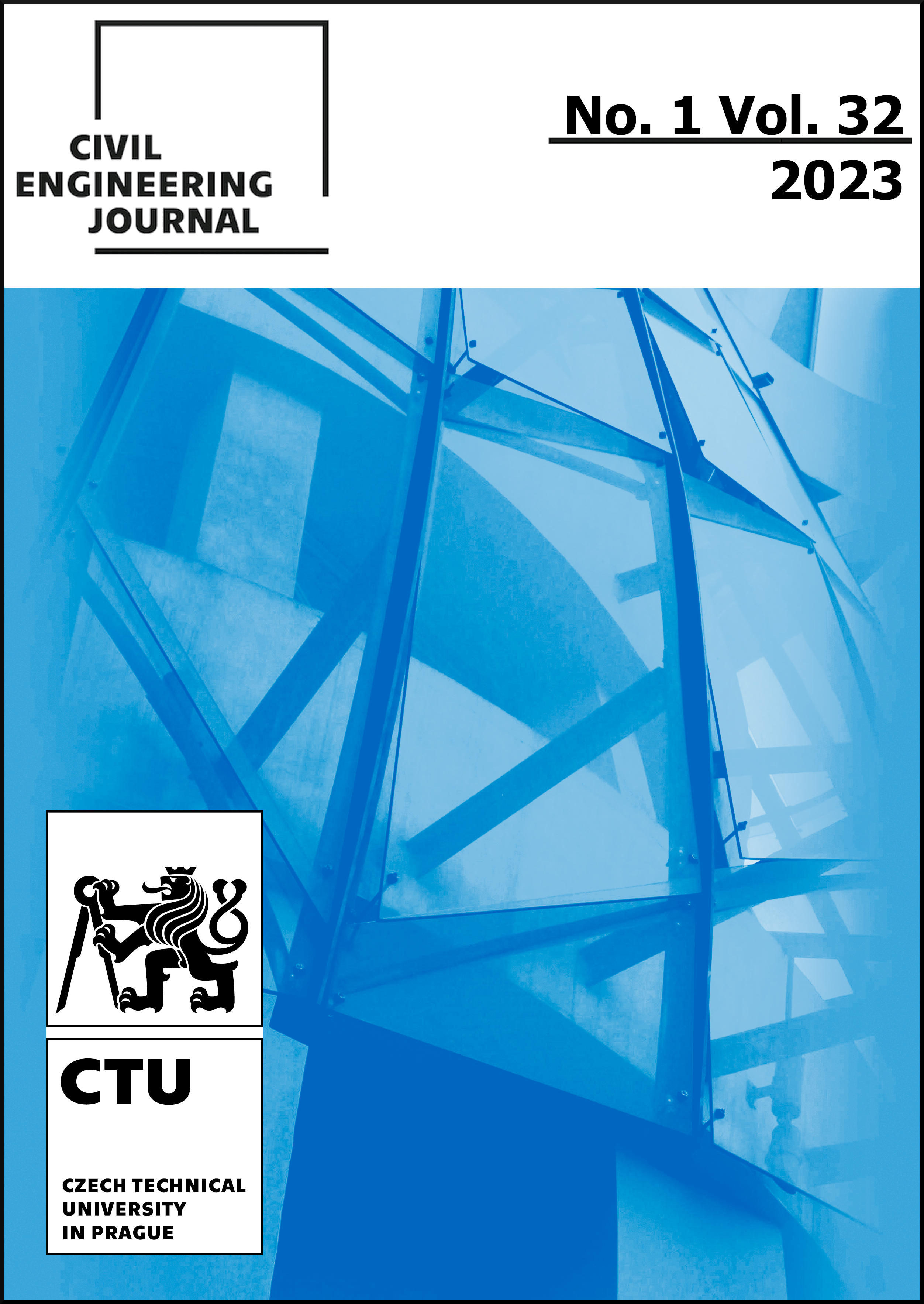AN INVESTIGATION OF DAMPING MODIFICATION FACTORS CORRESPONDING TO DIFFERENT DAMPING RATIOS FOR SDOF SYSTEMS
DOI:
https://doi.org/10.14311/CEJ.2023.01.0004Keywords:
Damping modification factor, Damping ratio, Site class, Elastic response spectra, Strong ground motion, Single-degree-of-freedom systemAbstract
The damping ratio is an important parameter in dynamic analyses and plays a key role in the design of building structures. Elastic response spectra are widely used in this design to describe the earthquake action in specific site classes. 5% damped response spectra are generally used for most of the conventional structures. However, other types of structures may not have a damping ratio of 5% and can have much lower or much larger damping ratios. The damping ratio is recommended at about 5% for concrete structures whereas it is estimated at 2% for steel structures. Tall slender buildings may have much lower damping ratios and low-rise buildings may be designed using much larger damping ratios than 5%. For these types of buildings, elastic response spectra are modified to account for different levels of damping ratios. This study proposes the damping modification factors (DMFs) which are computed using 5% response spectra as the benchmark. A strong ground motion set has been selected for the stiff site class and the displacement, pseudo-velocity, and pseudo-acceleration response spectra have been computed for single-degree-of-freedom (SDOF) systems. DMFs have been obtained in terms of these spectra and 3%, 10%, 20%, and 30% damping ratios have been considered. Variations of DMFs with different damping ratios have been obtained graphically. It can be seen from the results that DMFs are sensitive to the vibration period of the SDOF system.
Downloads
References
Chowdhury I, Dasgupta, SP, 2003. Computation of Rayleigh Damping Co-efficient for Large Systems. Electronic Journal of Geotechnical Engineering, vol.43: 6855-6868.
Mario P, 2004. Structural Dynamics: Theory and Computation, 2nd Edn. CBS Publishers and Distributors, New Delhi.
Chopra AK, 2006. Dynamics of Structures, 3rd Edn. Wiley, London.
Conde-Conde J, Benavent-Climent A, 2019. Construction of Elastic Spectra for High Damping. Engineering Structures, vol.191: 343-357.
Davalos H, Miranda E, Bantis J, Cruz C, 2022. Response Spectral Damping Modification Factors for Structures Built on Soft Soils. Soil Dynamics and Earthquake Engineering, vol.154, https://doi.org/10.1016/j.soildyn.2022.107153.
Ha T, Shin S-H, Kim H, 2020. Damping and Natural Period Evaluation of Tall RC Buildings Using Full-Scale Data in Korea. Applied Sciences, vol.10(5): 1568, https://doi.org/10.3390/app10051568.
Cruz C, Miranda E, 2017. Evaluation of Damping Ratios for the Seismic Analysis of Tall Buildings. Journal of Structural Engineering, vol.143(1): 04016144, DOI:10.1061/(ASCE)ST.1943-541X.0001628.
Hernandez F, Astroza R, Beltran JF, Belmar L, 2020. A Damper-Spring Device for Seismic Energy Dissipation in Buildings. 17th World Conference on Earthquake Engineering, 17WCEE, Paper No: C001492, Sendai, Japan.
Sheikh MN, Tsang H-H, Yaghmaei-Sabegh S, Anbazhagan P, 2013. Evaluation of Damping Modification Factors for Seismic Response Spectra. Australian Earthquake Engineering Society 2013 Conference, November 15-17, Hobart, Tasmania.
Newmark NM, Hall WJ, 1973. Procedures and Criteria for Earthquake Resistant Design. Building Practices for Disaster Mitigation, Building Science Series, vol. 46, National Bureu of Standards: Washington, DC. P. 209-23.
ATC-40, 1996. Seismic Evaluation and Retrofit of Concrete Buildings. Applied Technology Council, Redwood City, CA.
FEMA-273, 1997. NEHRP Guidelines for the Seismic Rehabilitation of Buildings. Federal Emergency
Management Agency, Washington, DC, USA.
UBC, 1997. Uniform Building Code. International Conference of Building Officials, Whittier, CA.
Eurocode 8 (EC8), 2004. Design of Structures for Earthquake Resistance, Part 1: General Rules, Seismic Actions and Rules for Buildings. EN 2004-1-1, CEN, Brussels.
ASCE 7-05, 2006. Minimum Design Loads for Buildings and Other Structures. American Society of Civil Engineers, 1801 Alexander Bell Drive, Reston, VA 20191, USA.
Mexico City Building Code, 2017. Complementary Technical Standards for Earthquake Design in Regulation of Constructions of the Federal District. NTCS-17, Official Gazette of the City of Mexico, Mexico.
Priestley MJN, Calvi GM, Kowalsky MJ, 2007. Displacement-Based Seismic Design of Structures. IUSS Press: Pavia, Italy.
PEER, 2022. Pacific Earthquake Engineering Research Center Strong Ground Motion Database. http://ngawest2.berkeley.edu/.
TBEC, 2018. Turkey Building Earthquake Code. Ministry of Public Works and Settlement, Ankara, Turkey.
SeismoSpect, 2022. Seismosoft, Earthquake Engineering Software Solutions, Pavia, Italy, https://seismosoft.com/.
Fernandez-Davila, VI, Mendo A., 2020. Damping Modification Factors for the Design of Seismic Isolation Systems in Peru, Earthquake Spectra, 1-28, DOI: 10.1177/8755293020926189.
GB 50011, 2010. Code for Seismic Design of Buildings. China Architecture & Building Press, Beijing, China.
BCJ, 1997. Structural Provisions for Building Structures. 1997 Edn-Tokyo: Building Center of Japan [in Japanese].
Chopra AK, 1995. Dynamics of Structures, Theory and Applications to Earthquake Engineering, Prentice Hall, Upper Saddle River, N.J.
Downloads
Published
Issue
Section
License
Copyright (c) 2023 Author

This work is licensed under a Creative Commons Attribution-NonCommercial 4.0 International License.
Authors who publish with this journal agree to the following terms:
- Authors retain copyright and grant the journal right of first publication with the work simultaneously licensed under a Creative Commons Attribution License that allows others to share the work with an acknowledgement of the work's authorship and initial publication in this journal.
- Authors are able to enter into separate, additional contractual arrangements for the non-exclusive distribution of the journal's published version of the work (e.g., post it to an institutional repository or publish it in a book), with an acknowledgement of its initial publication in this journal.
- Authors are permitted and encouraged to post their work online (e.g., in institutional repositories or on their website) prior to and during the submission process, as it can lead to productive exchanges, as well as earlier and greater citation of published work (See The Effect of Open Access).
How to Cite
Accepted 2023-02-09
Published 2023-04-30











